Wellington Zoo
Wellington Zoo is in the green belt of Wellington, New Zealand.
 Wellington Zoo's logo | |
Tahi the one-legged kiwi, Wellington Zoo's unofficial mascot. Tahi means 'one' in the Maori language. | |
| Date opened | 1906[1] |
|---|---|
| Location | 200 Daniell Street, Newtown, Wellington, New Zealand |
| Coordinates | 41°19′11″S 174°47′03″E |
| Land area | 13 hectares (32 acres) |
| No. of animals | 500+[2] |
| No. of species | 100+[2] |
| Memberships | ZAA[3] |
| Website | wellingtonzoo |
History
Wellington Zoo was opened in 1906[1] by the late Prime Minister Richard Seddon, after he was given a young lion – later named King Dick – by the Bostock and Wombwell Circus. Over time the zoo was expanded and upgraded.
Historically, Wellington Zoo operated under the auspices of the Wellington City Council. However, in June 2003 the zoo became a charitable trust and is now governed by a board of six trustees, with the Wellington City Council as principal source of funds.
Wellington Zoo's current group of chimpanzee originate from a male named Tom and two females named Yoka and Sarah. Yoka gave birth to daughters Bebe in 1962, Jodie in 1977 and Jessie in 1978 while Sarah gave birth to a son, Sam, in 1977. Bebe then bred with Tom to produce two sons, Boyd in 1978 and Marty in 1987. Wellington Zoo used to hold chimpanzee tea parties which were phased out during the early 1960s.[4]
1960s
.jpg)
On 18 March 1967 a zookeeper failed to properly secure a tiger enclosure leading to the escape of 2 tigers named Napoleon and Josephine. The tigers were reportedly seen walking the streets in the suburb of Newtown where the zoo is located. The two tigers were tracked down overnight and eventually killed after advancing aggressively towards police and a group of circus performers who were attempting to contain Josephine with a net.[5] There was considerable public outrage at the destruction of the animals particularly as Josephine had already been shot with 2 tranquiliser darts. Police justified their actions were necessary in order to ensure public safety.[6]
1990s
In 1990, Wellington Zoo received its first Sumatran tiger, a two-year-old male named Jambi, from Taronga Zoo. He was joined in 1992 by a two-year-old female, Toba, from Rotterdam Zoo. Toba died in 1993 and was replaced by a two-year-old female, Cantic, from Arnhem Zoo in 1994. Cantic gave birth to a litter of three cubs in 1996. The male, Rokan, remained at the zoo, while the females, Nisha and Malu, were sent to Auckland Zoo in 1998.[7]
In 1992, three female chimpanzee arrived from Taronga Zoo, 11-year-old Cara, 9-year-old Samantha and 7-year-old Sally. Jodie gave birth to a son, Gombe, in 1993. In 1994, Cara gave birth to a daughter Chima, while Samantha gave birth to a son, Temba. In 1996, Sally gave birth a son, Mahinga. In 1998, Samantha gave birth to a daughter Keza, while Cara gave birth to a son, Alexis.[4]
In 1992, two Malayan sun bears arrived from San Diego Zoo. They were originally named Stanley and Spot but were renamed Bakti and Chomel. In May 1997, Chomel gave birth to twins which died at birth. She gave birth again in December 1997 but the cub shortly died after birth.[8] Chomel gave birth again to male twins in April 1999. The cubs were named Arataki and Madu.[9]
In 1998, giraffes Ricki and Tisa, had their first surviving calf, Ndoki. The male calf was sent to Hamilton Zoo the following year.[10]
2000s
In January 2000, Sumatran tigress, Cantic, gave birth to her second litter. The three cubs were named Jaka, Molek and Mencari and were sent to Hamilton Zoo in January 2001.[11] In October 2001, Jambi died after eating contaminated meat. Cantic also ate the meat but recovered. His death left Wellington Zoo without a breeding male.[12]
In January 2000, chimpanzee, Sally, gave birth to a son named Bahati. In 2002, chimpanzee, Josie, died of cancer, followed by the death of her elder sister Bebe in 2003. In 2003, Cara gave birth to a son, Hasani, who died at three months of age. Sally gave birth to an unnamed son in 2005 who was euthanised after Sally rejected him. That same year, Sally's two sons, nine-year-old Mahinga, and five-year-old Bahati died following illnesses.[4] Bahati had developed pneumonia and, for a brief period of time before his death, was also looked after by the adult Intensive Care doctors from nearby Wellington Hospital.[13] In 2007, Sally gave birth to a son, Beni.[14] In 2009, Boyd and Gombe left for Monarto Zoo in Australia.
In May 2001, arrangements were made for Malayan sun bear Madu to be sent to the National Zoo in Australia but he died following surgery on a broken tooth. An autopsy revealed he had a hole in his heart. His twin, Arataki, was sent instead.[9] Bakti died in August 2001, leaving the zoo without a breeding male. In September 2004, a seven-year-old male named Sean, arrived from Perth Zoo. He had been rescued as a cub from outside a restaurant in Cambodia by the Free the Bears Foundation.[15] Chomel gave birth to a female cub in September 2006, named Sasa. At that time, Wellington Zoo was the only zoo in Australasia to successfully breed a sun bear.[16] Chomel died in September 2009, following a stroke.[17]
In September 2001, giraffe Tisa, gave birth to her second surviving offspring, a female named Rukiya. She was transferred to Auckland Zoo in September 2002 and has had several calves there.[18] In March 2004, Tisa gave birth to her seventh calf, and third surviving calf, a female named Zahara. She has remained at Wellington Zoo.[18] In November 2007, the zoo's breeding male, 20-year-old Ricky, died.[19] A new male, Seun, arrived in April 2008, from Orana Wildlife Park, where he was born in late 2006.[20]
2010s
In October 2010, chimpanzee, Samantha, gave birth to a daughter, Malika.[21] Sally gave birth a son, Bakari, in 2012.[22]
In March 2012, giraffe, Zahara, went into labour with her first calf. The labour did not progress and a caesarian was needed to remove the female calf, which was already dead.[23] Zahara recovered well and will breed again in the future, despite the death of breeding male, Seun, in September 2012. The zoo, now left with Tisa and Zahara, is currently looking to import a new male giraffe, or use artificial insemination on the younger female, Zahara.[24]
In September 2012, Wellington Zoo opened a new enclosure for their Malayan sun bears, Sean and Sasa.[25] The zoo is currently awaiting the arrival of a new male sun bear for breeding with Sasa. She is currently on a contraceptive implant to prevent breeding with her father, Sean.[26]
In August 2013, 21-year-old Sumatran tiger Cantic died. She was one of the oldest tigers in captivity.[27] In June 2014, a 3-year-old Sumatran tigress, Senja, arrived from Mogo Zoo. She is the second cousin of Rokan so a new male will be imported later in the year.[28]
In September 2014, Wellington Zoo opened their newest exhibit, Grassland Cats, home to the zoo's servals and new caracals, the first ones in the country for a long time.[29]
Conservation and sustainability
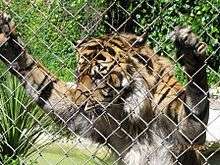
Wellington Zoo is committed to the welfare of animals and wildlife both within the zoo and around the world. As well as caring for their own animals, Wellington Zoo participates in breeding programs both locally and internationally, and contributes to conservation and research programs both within the zoo, around the country and even overseas.
It works cooperatively with other zoos around the world through studbook keepers, who are responsible for maintaining relevant data on a particular species within a programme to ensure genetic diversity. Wellington Zoo is a full institutional member of the Zoo and Aquarium Association (ZAA).[3]
In addition to breeding programmes, the zoo is also involved in a number of community conservation projects. The Kereru Discovery Project is a cooperative effort with Zealandia: Karori Wildlife Sanctuary, Te Papa and Pukaha (Mount Bruce).[30] This project aims to make Wellington a better place for kereru, the native wood pigeon.[31] Places for Penguins is a cooperative effort with Royal Forest and Bird Protection Society of New Zealand to identify and protect nesting areas used by blue penguins around Wellington coastal areas.
Interaction
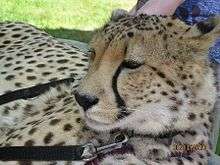
A variety of talks and demonstrations are held on a day-to-day basis including the chance to meet Wellington Zoo's unofficial mascot, Tahi the one-legged kiwi, up close.
At The Nest – Te Kōhanga, visitors can observe and ask questions of the zoo veterinarians while they provide previously behind-the-scenes medical care to a wide range of animals on a daily basis.
Zoo Capital Development Programme

The Nest – Te Kōhanga animal hospital allows the public to watch the wildlife vets at work, narrating as they handle check-ups and surgeries and answering questions through an incorporated intercom system. Coming soon is 'Meet the Locals', an area dedicated to local fauna and conservation. Much more will be unfolding over the next few years, including the Asia Precinct and The Roost native bird care and breeding facility.[32]
The Nest – Te Kōhanga
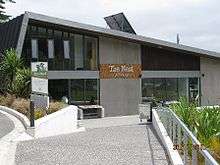
The Nest – Te Kōhanga is Wellington Zoo's latest major addition, with facilities and equipment to treat every animal resident of the zoo, except the giraffes, and is also used for rescued native wildlife. Each of the main surgical rooms has an open viewing gallery and a communication system, allowing staff to narrate procedures for visitors and visitors to ask questions of staff.
Animals
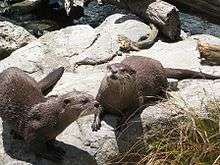
Mammals
- Carnivores
- Omnivores
- Malaysian sun bears
- Chimpanzees
- Hamadryas baboons
- White-cheeked gibbon
- Cotton-top tamarins
- Golden lion tamarin
- Pygmy marmosets
- Meerkats
- Hedgehogs
- Red pandas
- Brown rat

- Herbivores
- Giraffes
- Nyala
- Black and white ruffed lemur
- Spider monkeys
- Eastern grey kangaroo
- Tammar wallaby
- African crested porcupines
- Capybara
- Common agouti
- Kunekune

Birds
- Aquatic
- Terrestrial
- Ostriches
- Emus
- Guinea fowl
- Himalayan monal
- Bantam
- Buff-banded rail
- Brown kiwi
- Parrots
- Sulphur crested cockatoos
- Red-tailed black cockatoos
- Red-fronted macaw
- Sun conures
- Kea
- Kaka
- Pigeons
- Crested pigeons
- Emerald doves
- Kereru
- Predatory
- Tawny frog mouth
- Morepork
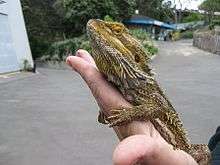
Reptiles and amphibians
- Aquatic
- Southern bell frogs
- Leopard tortoise
- Red-eared sliders
- Axolotl
- Australian water dragons
- Terrestrial
Spiders
- Goliath bird-eater spiders
- Redkneed tarantulas
- Chilean rose tarantulas
- Costa-rican zebra tarantulas
- Peruvian pinktoe tarantulas
- King baboon spiders
Fish
Attacks
In 2006 zookeeper Bob Bennett was mauled by two lions Malaik and Zulu when an unlocked gate allowed them entry into the area where he was laying out their food. He was rescued by zookeepers with relatively minor injuries.[33] The incident was also featured in an episode of Untamed and Uncut.
References
- "History". wellingtonzoo.com. Wellington Zoo. Retrieved 12 September 2010.
- "Our Collection". wellingtonzoo.com. Wellington Zoo. Retrieved 12 September 2010.
- "Member Location Map". zooaquarium.org.au. ZAA. Retrieved 12 September 2010.
- http://researchcommons.waikato.ac.nz/bitstream/handle/10289/2635/thesis.pdf?sequence=2
- "Shots End Dramatic Hunt - Tigers prowl streets". The Dominion. 60 (149). 20 March 1967. p. 1.
- Hunt, Tom (16 March 2013). "Flashback: Surreal tiger hunt in streets of Newtown". The Dominion Post.
- "Wellington Zoo - New tigeress planned at Wellington Zoo". [sic]
- http://www.izn.org.uk/Archive/292/IZN-292.html
- "Wellington Zoo news".
- "Hamilton Zoo - Hamilton Zoo".
- "Hamilton Zoo tiger siblings to celebrate their 10th birthday - infonews.co.nz New Zealand's local news community". www.infonews.co.nz. Retrieved 27 September 2018.
- "Tiger death still a mystery".
- "(PDF) Intensive care in an unusual setting: Management of pneumonia in a chimpanzee".
- http://www.wellingtonzoo.com/net/news/article.aspx?id=11
- http://www.wellingtonzoo.com/net/news/article.aspx?id=200
- http://www.wellingtonzoo.com/net/annual-reports/annual-report07/conservation.html
- "Wellington.scoop.co.nz » Wellington Zoo: Chomel the sun-bear dies after stroke".
- "Viable/non viable species".
- "Wellington Zoo - giraffe death".
- "Open Range Zoo, Christchurch NZ | Orana Wildlife Park".
- http://www.wellingtonzoo.com/net/explore/animals.aspx?id=27
- Wellington Zoo [@WellingtonZoo] (8 August 2014). "Our youngest chimp Bakari had his eye on the prize at lunch time. Luckily his mum Sally doesn't mind sharing!" (Tweet) – via Twitter.
- "Zoo's history-making surgery".
- "Wellington Zoo giraffe dies after operation". NZ Herald. 13 September 2012.
- "New homes for tigers and sun bears".
- "Sun bear breeding program advances".
- http://www.wellingtonzoo.com/net/news/article.aspx?id=361
- http://www.wellingtonzoo.com/net/news/article.aspx?id=408
- http://www.wellingtonzoo.com/net/news/article.aspx?id=416
- "Kereru Discovery Project: Partners". kererudiscovery.org.nz. Kereru Discovery Project. Retrieved 12 September 2010.
- "Kereru Discovery Project". kererudiscovery.org.nz. Kereru Discovery Project. Retrieved 12 September 2010.
- http://www.wellingtonzoo.com/content/development/meet-the-locals.aspx
- Cheng, Derek Cheng Kevin Taylor (11 January 2006). "Wellington Zoo investigates lion mauling". NZ Herald.
External links

- Official website